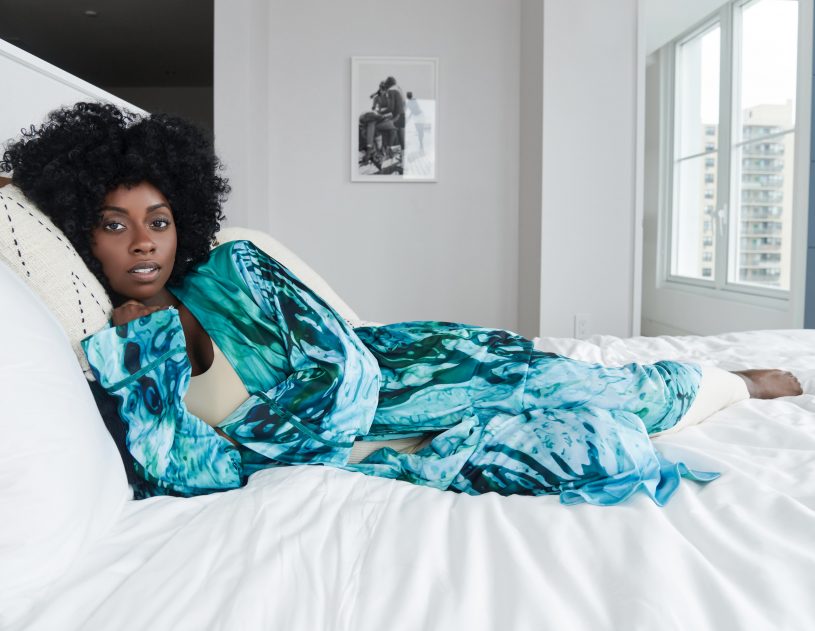Pattern Village combines chic flair with functionality for the perfect sustainable-made garment.
Many say it takes a village to bring something to life. For Aundrea Kudrna, Pattern Village’s cultivation came to fruition in New York, as it is an extended love affair with the Big Apple. The brand defines the results of the hustle and grind, the unimaginable and overall people. Not to mention, the desire to throw in fresh, colorful, bold patterns to today’s sustainable fashion closet. As Kudrna offers effortless elegance via the New York touch for Pattern Village, Fashion Manuscript took the time to speak with the designer on her inspirations, intentions, and more.
What inspired you to create Pattern Village?
No one asks me that, and the inspiration is one of my favorite things in the world. So many things inspired me along the way [such as] my own personal travels and just wanting a garment that I could wear from day to night that had functionality and was chic and interesting. I like to pack light when I travel and to have things on me that I can wear at any part of the day. That’s where Pattern Village’s inception started. Also, people are drawn to eccentric things. I felt like in the eco-fashion world, bold, colorful patterns just weren’t being done. I’m a lover of organic and light colors, and I thought a colorful option was missing from a sustainable wardrobe.
Where did the name Pattern Village come from?
I am a huge lover of artistic patterns. It also has to do with the structure of the garment, the process of sewing it and going through how someone can find a garment easy and useful. When we put in pockets, I wanted them to have zippers so that if you’re walking on the beach and you’re wearing a dressing gown as a cover up, you can have your credit card zipped in your pocket and not have to worry about it. Then on the inside, there’s another component to the structure because I also didn’t want you to put something heavy in your pocket and feel like the garment was heavy and dragging you down. So, to resolve this, we put a specific attachment that goes in any dressing gown and holds up heavy objects in your pocket. It’s just very specific details that go into designing the pattern of a garment that I found super interesting to dive into. Then this idea of “pattern” needed to be part of the name because that’s in the brand itself. “Village” comes from: it takes a village. It’s not just me, it’s garment manufacturers in New York. It’s the textiles from New Jersey. It’s the patternmaker in Queens. It’s everyone that I work with that brought Pattern Village to life with me, and it even extends beyond that to the people who support it and purchase our garments. They are part of the village as well. When you purchase from Pattern Village, you’re part of the village. Whenever I design something, I want it to be as inclusive as possible for all body types and tastes.
What is your relationship with New York, Pattern Village’s home?
New York inspired Pattern Village. I’ve lived here for so many years and have such a love for this city as well as the creativity it gives to everyone. Sitting on a stoop in New York City, you watch a runway unfold in front of you. That’s always been influential for me. I’ve been coming to New York since I can remember. My parents were small business owners. They’d take us on trips all the time and I remember being a second grader sitting in traffic in Chinatown and thinking, “I have to live here.” It’s a city that’s 24/7. You can dress how you want. You can be who you want. I was the kid going back to school with sneakers on 6-inch platform heels. I think my family, being in small business, inspired the entrepreneurial part of me. Them also bringing us to New York so much made it as if New York was always in my future. There was never another option. When I went to college, I only applied to New York schools. I went to St. John’s and moved to Queens and fell in love with the borough. From there, I’ve lived all over New York.
Everything you create is eco-friendly. What makes your garments sustainable?
The dressing gowns are made from 100% water bottles. Our fabric is all certified and is PFAS-free. Everything is made in the Tri-State area, as the garments are printed in New Jersey and sewn in Brooklyn. I’m always trying to keep a low carbon footprint and support local garment manufacturers and an industry that is so often being pushed to other places. Pattern Village is really showing that eco-fashion can be manufactured in New York. The goal is always to maintain a price for more people to experience the brand. All our packaging is biodegradable and uses safe inks and is FTCC-certified. Everything we do, from beginning to end of the product lifeline, is with sustainability in mind. For every purchase, we plant a tree. I work with One Tree Planted, which plants trees where they’re most needed in the USA for forest fire replenishment, mostly in Colorado and California.
What is behind your design process?
The inspiration comes from what I see around me. It ties back to what I see in New York, following with what I see on the road. Travel plays a huge part of what I put into the design. The Water Crush dressing gown comes from my time spent in Morocco, the sapphires and turquoise colors. The blues you see rippling through the cities of Morocco are like no other. I really wanted to capture that in a pattern and that became the Water Crush dressing gown. Nature plays a huge role, too. If you look at Safari Lust, I went with the giraffe print. In fashion, giraffe doesn’t receive as much love as some of the other animal prints. I also wanted to make the pattern look as if the giraffe was walking, so you’ll see crumbled lines that are really cool. We also figured out how to make sunspots, so when you’re wearing the dressing gown in the sun, it literally looks like the sun is shining on a giraffe throughout the pattern. With all of the patterns, I want people to look at it and think, “That’s me. It makes me feel something, remember something, or want to visit a place.” At the beginning of the design process, I sketch it out and do a ton of mood boards. Then I like to work with a different female artist on each one. I’ll collaborate with a surface pattern designer on each pattern. For example, on Loverland, I worked with an artist named Mardula and we talked about the wanderlust, desert utopian aspect that I wanted to get across with that pattern. She painted it all. We then digitally painted it so it can become a pattern for the dressing gown. At the end of the day, like I said, it really takes a village. It’s finding other designers that have a love for the brand as well and want to be part of it. Then we collaborate and work together on these beautiful patterns that are born.
How do you find these designers and artists to work with?
Instagram has been the best tool for that. There’s a community of designers that are constantly posting their work on Instagram. I really get into the weeds of finding the right ones. When you’re on Instagram, you don’t need a thousand likes for me to find your post. It’s about finding designers I really connect with. I also work with people I know. For example, my cousin designed Safari Lust with me. I was working on it for so long and I thought, “I need someone else to work on this pattern and get it to the finish line.” It just so happened that my cousin was the perfect person. She understood my idea for the sunspots on the giraffe dressing gown immediately and pieced it together.
What makes the garments you’ve launched different from others in the market?
I don’t think anything in the market is similar to the line of dressing gowns that I launched. The garment is so unique in terms of being able to wear it as a swimsuit cover up to brunch, as a dress to lunch, for cocktails, and more. The fact that it’s UPF fabric is another aspect that differentiates the product from anything else on the market. What also makes the dressing gowns so special is the fact that they are made from recycled water bottles and contain artistic, bold and beautiful patterns. Overall, the piece can be used for so much. It’s really a travel garment that’s made to go with you throughout the day. Then when you look at our jumpsuits, it all comes back to an outfit that is chic and comfortable but also has function to it. The straps are adjustable, but so are the pant legs.
How often do you drop new items? Can we have a sneak peek of what’s to come?
I came back from Greece filled with ideas. Next summer has so much in the works. I do one new dressing gown pattern a year, which I launch in the spring before the start of summer. Last year, I introduced the jumpsuits. I have some fun plans for the jumpsuits, and I plan on extending the color lines. I’m also looking at new sustainable fabrics.
You’ve also been working in the hotel industry for years. How do you balance working in hospitality and the fashion business?
Hotels are always part of what I do, and they’ve inspired so much of Pattern Village. There are some fun hotel projects in the future that will come around. I’m also moving into this new role that’s very much tied to the retail world, so it is related to what I do.
How do you look forward to making fashion more sustainable in the future?
I’m really focused on making sustainable fashion more accessible for people. I’m always thinking of the price tag and how we can put the best out there for the consumer to be able to purchase sustainable fashion. I don’t mark up prices and there’s no middleman between the consumer and I. That’s my goal at the end of the day.











